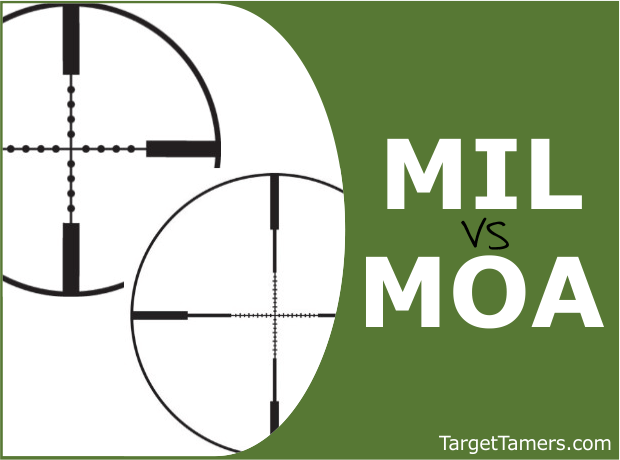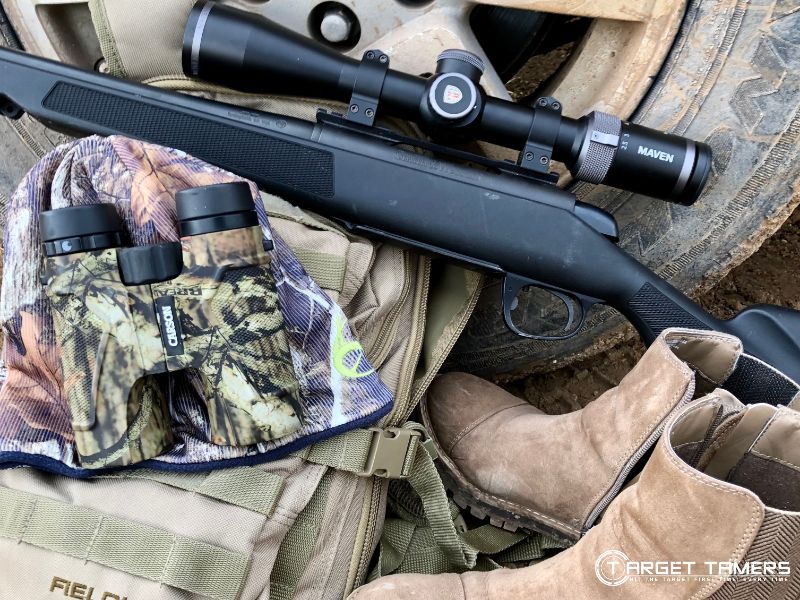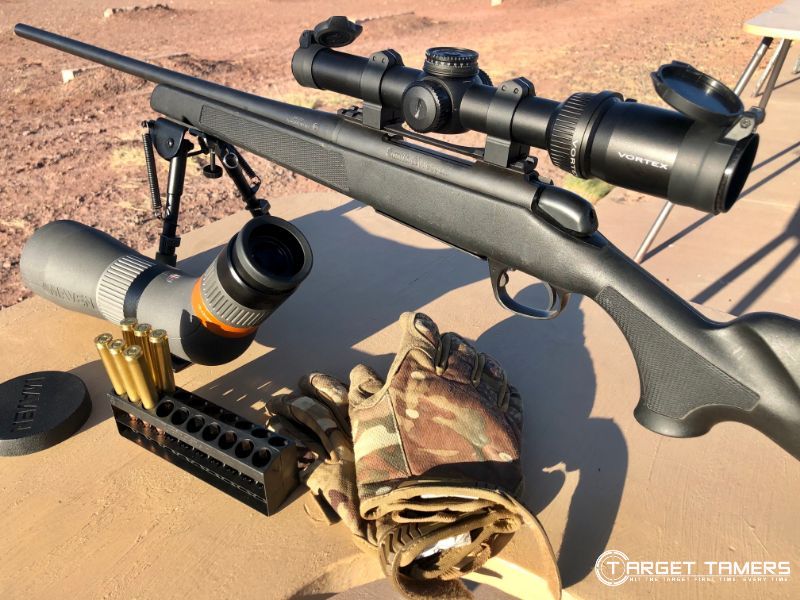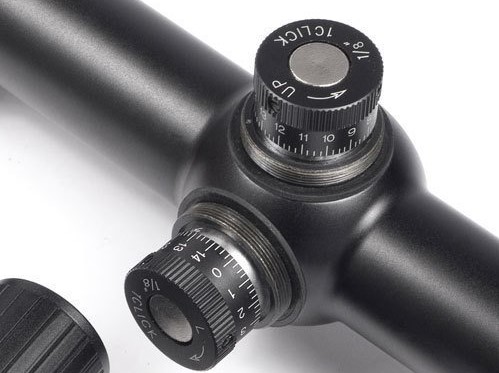
Are you stressing about which system you want on your new scope?
Not sure about the differences between the two?
Will your choice make a huge difference in the field?
There are a few things you're going to need to ask yourself before making the final decision. What are we waiting for? Let's get to it!
First: Some Self-Evaluation
Ask yourself a few of these questions to help guide you in your scope research and buying process. It may help to eliminate some confusion and narrow down the options.
- What are you hunting? Big game, small game, varmints, etc.
- What is your hunting range? Close or long range, extreme long range.
- What firearm do you have?
- Does your spotter/spotting scope have a reticle? Do you need to match your scope system to your spotter reticle? What system does your spotter know?
- What system are you already familiar with? MOA or mil-dot?
- What measuring system do you use in your rangefinder? Yards or meters?
- Do you naturally think in yards or meters?
- Is your dope card in meters or yards?
- Do you use your scope to measure distance?
- Is this scope for hunting or military use?
These are just some points to think about that may naturally encourage you towards one system versus another.
MOA vs Mil-Dot Differences
1. For Hunting

What is your hunting range? Many hunters simply holdover using their reticle for shorter ranges, and when it comes to long range, then you might want to consider accuracy, your ability to run some quick math formulas, and how much money you’re willing to drop into your long range scope.
If you’re insistent on choosing your next scope based on the measuring system you want to use for hunting, we highly encourage you to stick with the measuring system you know best.
There is a common belief that MOA is for inches and yards and mils is for the metric system and that’s it. It’s not a bad belief since the math remains a little easier when you think that way. But, you can use mils and still do the math to get inch and yard measurements.
It just takes a little more know-how, but you’re not left to only choosing one type of scope “just because.”
Winner: Tie
2. For Beginners
Do you know the metric system, i.e. centimeters and meters? Or, are you more familiar with the U.S. Standard measuring system with inches, yards, and feet? It's less about being a beginner or pro, because it's more about knowing your measuring system well.
Common practice tells us that MOA is much easier for those familiar with the U.S. measuring system, because it works cohesively with inches and yards.
Mil can be used with both the imperial and metric system, although, those who know the metric system will find mils much easier to use and do the math. Just as a side note, mil is not a metric measurement!
With that said, it doesn't mean you're simply stuck or doomed if you don't know metric. If you know MOA and inches, and you want a mil-dot scope, you can learn all about Mils, inches, and yards with our Mil-dot article.
There are some formulas involved, and sometimes the math just confuses the heck out of you taking away from the enjoyment of shooting. But, that's why you have a dope card with you, right? And, if you know your mils, you can quickly holdover using the dots on the reticle to make very fast shots.
So, what's the right one for a beginner? It's the one with the measuring system that you are familiar with.
Winner: Tie
3. For Accuracy

As we know, accuracy really is determinant on scope quality. Shooter skill and experience, terrain, weather, mirage, and multiple other factors also contribute to how accurately you can hit your target. Reticle subtension even comes into play. How fine are your adjustments on your turret? 1/10, 1/4, 1/8?
But, you still insist on asking if MOA or Mil is more accurate than the other. Neither one is inherently more accurate or consistent than the other. They are simply angular measurements with differing scales.
But, if we're strictly talking about how much of an adjustment difference you can make when you hear that 'click,' then let's do the math.
At 1000 yards, 1 mil = 36" or 100 cm. One 1/10th click translates to 3.6" or 10 cm.
At 1000 yards, 1 MOA = 10.47". One 1/4 MOA click translates to 2.6".
At 1000 yards, there's a 1" difference between the two, and at 100 yards, this only translates to a 0.1" difference. MOA may be slightly more accurate, but most shooters, including myself, can’t hold over accurately enough to notice the difference.
Heck, if you can, what are you doing here? For the sake of pitting them against each other, MOA takes the gold.
Winner: MOA
4. For Long Range Hunting
FFP (First Focal Plane) mil scopes with 0.1 mil increments indicated on both the windage and elevation crosshairs have an excellent advantage in the field for extreme long-range shots. You can use it to mil for a target size and distance, and in combination with the metric system, it’s a wrap.
However, it’s extremely difficult to measure accurately down to the 1/10th or even finer if you’re not experienced with this. It also makes for a very busy reticle which may be necessary for long range shots.
Arguing back and forth between which system is better is not helpful. But, if we take the accuracy argument above, we can see that MOA allows for finer adjustments at longer ranges.
MOA scopes are also available in even finer adjustments of 1/8 MOA increments. However, to effectively use those adjustments at long range, you must be using precise formulas that maintains a true 1 MOA is equal to 1.047 inches.
Winner: MOA

5. Milling Targets
Milling a target means to get a distance by using your reticle to measure a target. In this case, we know Mil reticles have this, hands down. The only problem is, very few shooters do this anymore.
Very few hunters can accurately measure target size in mils through a scope, let alone trying to get a still sight picture in field conditions. Outside of a professional exercise and military scenario, we all whip out our laser rangefinders to get the distance.
Pro snipers can train their eyes to measure and see down to 0.1 mil that is the same as 1/10 of a click on a turret. Even fewer marksmen can see way down to 0.05 mil - that's five hundredths of a mil. Now, that's some precise milling, and it would have to take some specialized reticles with very fine subtension to do that.
When your laser rangefinder fails, and if you know how to do mil formulas, your day may not be over.
Winner: Mil
6. Dope Card Reading
This may seem like an obvious point to make, but we're doing it anyway. Let’s look at a dope card we've put together taken from real ballistics.
.308 Win. Federal Premium 150 grain Copper HP bullets.
| Range (Yards) | Elevation (Mil) | Elevation (MOA) |
|---|---|---|
| 500 | 3.5 Inches | 12.0 Inches |
| 600 | 4.9 Inches | 16.7 Inches |
| 700 | 6.6 Inches | 22.6 Inches |
| 800 | 8.6 Inches | 29.6 Inches |
As you can see, it's much easier to write in and read fewer digits associated with mil measurements. It may be a petty comparison, but it makes a big difference for some shooters to write in, read, and say.
Winner: Mil
7. Doing the Math
Which system is easier to do the math in a jiffy? Boy, we are really narrowing down the margins today! Both systems are going to require some math involved. It can't be helped. Even if you're using your own dope card or ballistics print-out, the math still had to be done.
Let's throw out some formulas in both mil and MOA measurements.
To calculate the mil/MOA size at any distance:
Mils – cm
- Target distance (meters) / 10 = 1 mil size in cm at that distance
- Example: 150 meters / 10 = 15 cm
Mils - inch
- (Target distance (yards) x 3.6) / 100 = 1 mil size in inches at that distance
- Example: (150 yards x 3.6) / 100 = 5.4 inches
MOA – inch
- Target distance (yards) / 100 = 1 MOA size in inches at that distance
- Example: 150 yards / 100 = 1.5 inches
OR
- (Target distance (yards) x 1.047) / 100 = 1 MOA size in inches at that distance
- Example: (150 x 1.047) / 100 = 1.57 inches
As you can see, it's much easier to make math solutions when you're working with simple constants like 10 and 100.
However, when we use the Mil system with inches and yards, it gets a little harder since we're using numbers like 3.6" and 27.778. Converting these measurements isn't easy, and it takes a bit more effort to memorize the formulas.
While doing the math, some may find it easier for metric users to stick with mils, and U.S. system users to stick with MOA.
Winner: Tie
8. MOA VS MIL: Which is More Popular?
How are we going to define popular? With what F-class pro shooters use? With what the military has standardized? Or, with what’s more readily available?
Mil scopes outnumber MOA scopes in the market. Does this mean it’s more popular? Not necessarily. MOA scopes and reticles are on the rise because it’s easier for U.S. shooters to use since it’s cohesive with the measuring system they know best.
However, when the military uses a certain system, the civilian world catches on too, and hunters want to try it out as well. We see proof of this with NATO-based cartridges that outsell other perhaps superior cartridges in the market.
Manufacturers outside of the U.S. also find it easier to industrialize down to offering only mil scopes whether it’s part of their business plan or whether it’s just an easier manufacturing decision to perfect one design. Does this mean mils is better than MOA? No, since there’s no inherent advantage.
However, it’s true that mil scopes dominate the market, and it’s also true in the spotting scope market. But, we know spotters are also coming out with MOA reticles like the Burris Signature HD with the SCR MOA eyepiece. Still, the winner remains clear.
Winner: Mill
Tip:
Match your reticle and your turrets. There's no point in having a mil-dot reticle with MOA turrets or vice versa if you don’t want to deal with the conversion math. Stick with a MOA reticle with MOA turrets, and Mil reticles with Mil turrets.
The Answer is Clear
When comparing Mil vs MOA, neither MOA or mil-dot has an advantage over the other. The right one for you really depends on what you know more about and what system you feel comfortable with.
If all you've known is MOA, then don't switch to mils. However, if your hunting buddy or spotter uses mils, one of you must get on the same page, and that would be much easier to do if you know both. But, when it comes to your own personal use, what system do you know better?
Further Reading
- Wire vs Glass Etched Reticles: Which Should You Choose for Your Rifle Scope?
- What Is Your Best Hunting Gear Investment? 25 Expert Hunters Weigh In
- What is the Sight Picture & Sight Alignment? [WITH PICS]
- What Is The Difference Between Reflex Sights VS Red Dot? Find Out Here!
- What Is MOA? Calculating Minutes of Angle & Making Turret Adjustments




At 1000 yards, 1 mil = 36" or 100 cm. One 1/10th click translates to 3.6" or 10 cm.
Surely 39.5" is 100cm?
36" = 91.5cm
Hi Daryl. Yes you're absolutely correct about the math when converting inches to cm. However, when calculating a linear distance from MILs, we're not doing conversions between cm and inches. It's a conversion from MILs (angular measurement) to either inches or cm. Chris "The Optics Nut" gives a great explanation from a similar question in our Mil Dot Explained guide in the comments section - you've gotta read this guide if you haven't already, it's good! Basically, 1 MIL is 1 MIL. What that translates to in a linear measurement downrange will either be 3.6" at 100 yards or 10cm at 100 yards. Multiplied by 10 for 1000 yards, 1 MIL is still 1 MIL, but it's now 36" or 100 cm large down range. Hope that helps!